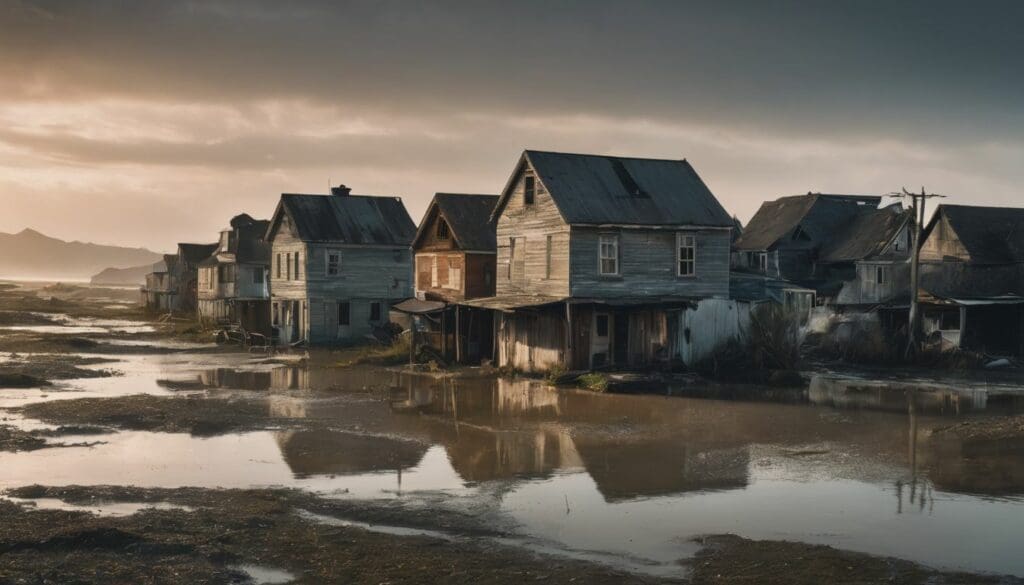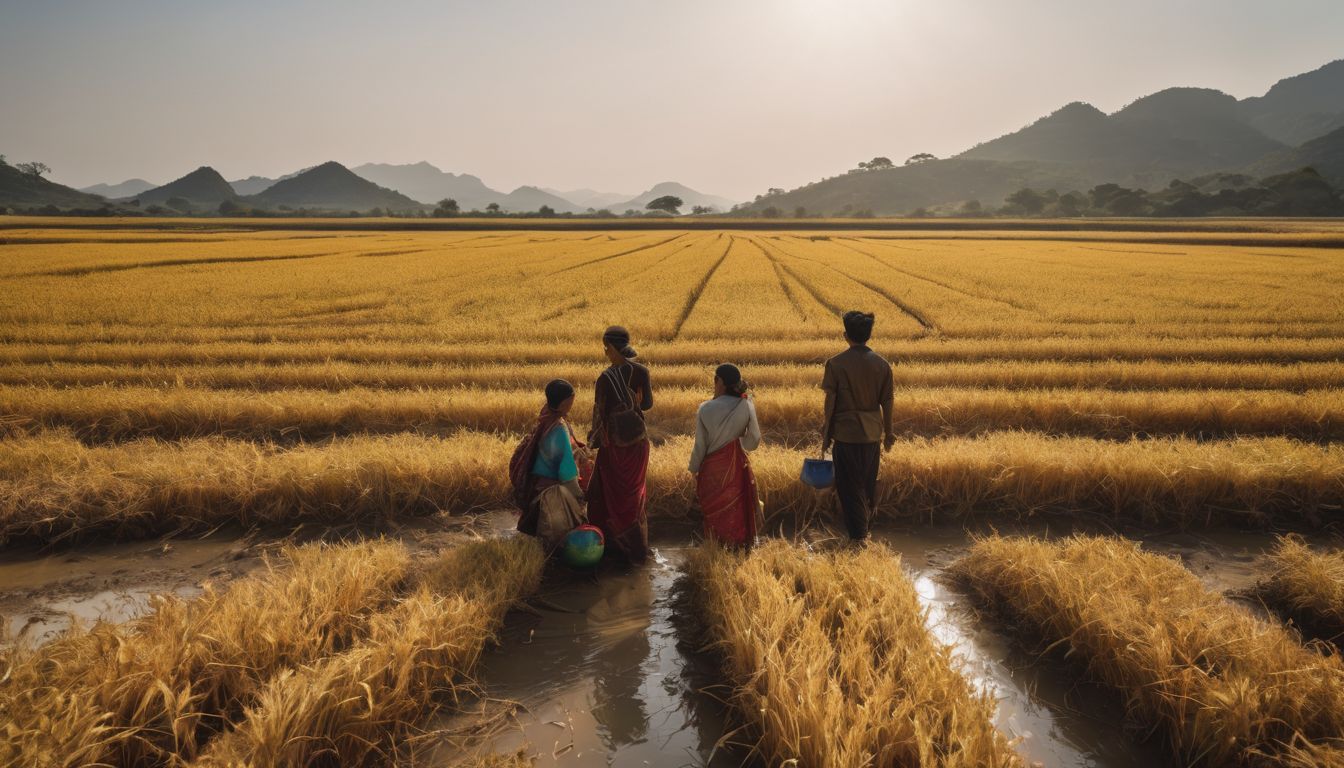As our planet warms, more people find themselves forced to leave their homes. Climate refugees are those who must flee because of extreme weather and rising seas. This blog will explore their stories, revealing the true human cost of climate change.
Stay with us for a journey through their eyes.
Key Takeaways
- Climate refugees are individuals forced to relocate because of environmental changes like rising sea levels, extreme weather, and droughts caused by climate change.
- These displaced persons often lack legal protection and support since there is no formal recognition for “climate refugees” in international law, leading to a gap in resources and aid.
- The displacement due to climate change can lead to overcrowding in safer areas, strain local resources, increase property prices, and contribute to conflicts over limited resources.
- Stories from those affected by climate – induced migration highlight the personal struggles faced such as loss of homes, livelihoods, and mental health challenges.
- Global cooperation on sustainable solutions is vital. Efforts include creating protective policies for displaced populations and promoting renewable energy sources to mitigate further environmental degradation.
What are Climate Refugees?
Climate refugees are people who are forced to flee their homes due to the impact of climate change, including natural disasters and environmental degradation. This displacement is often caused by severe weather events, rising sea levels, and loss of agricultural resources.
Definition
Climate refugees are people forced to leave their homes because of climate change. Rising seas, extreme weather, and drought push families from their lands. They seek safer places with more stable conditions after losing farms, houses, or jobs to environmental disasters.
These displaced individuals face a humanitarian crisis as they struggle for basic needs in new areas that might be ill-prepared for an influx of migrants.
Environmental migration is not yet officially recognised in international law as other forms of displacement are. This lack of recognition means fewer resources and less protection under current legal frameworks for those affected by such displacement.
The causes behind this growing phenomenon stretch from natural disasters amplified by global warming to slow-onset changes like desertification or sea-level rise eroding living spaces over time.
Now let’s delve into the specific reasons these migrations are happening more frequently around the world.
Causes
Having understood the definition of climate refugees, it’s important to explore the causes that drive people out of their homes. Climate change is a primary factor, leading to more frequent and extreme weather events such as hurricanes, floods, and droughts.
As a result, natural disasters destroy homes and make land uninhabitable. Additionally, overpopulation puts a strain on resources like water and food supplies, exacerbating environmental degradation and contributing to displacement.
Furthermore, resource depletion due to unsustainable practices adds pressure on communities already facing climate-related challenges.
Examples
- Causes such as rising sea levels have led to the displacement of communities in small island nations like Tuvalu and the Maldives.
- In Sub – Saharan Africa, prolonged droughts and desertification have forced people to migrate in search of arable land and water sources.
- The melting of polar ice caps has resulted in environmental migrants from regions like Alaska and Greenland as they face loss of livelihood due to disappearing habitats.
- In Bangladesh, frequent cyclones and flooding have left millions of people homeless, pushing them to seek refuge in other parts of the country or beyond its borders.
- The indigenous communities in the Amazon rainforest are facing relocation due to deforestation and development projects threatening their traditional way of life.
The Global Impact of Climate Change
Climate change has led to the displacement of communities, with rising sea levels and extreme weather events forcing people to leave their homes. This has also resulted in conflicts over dwindling resources and political instability in some regions.
Displacement of communities
Climate change has contributed to the displacement of communities around the world. Rising sea levels, extreme weather events, and dwindling resources have forced many people to leave their homes in search of safer places to live.
This involuntary migration has led to increased pressure on host communities and strained resources, fueling conflicts and political instability in some regions.
Many displaced persons face challenges in adapting to new environments, struggling with limited access to resources and opportunities as they seek safety away from climate-affected areas.
Climate-induced migration continues to be a pressing issue that requires urgent attention from governments and international agencies.
Effects on resources
Climate change is causing significant disruptions to vital resources such as water, food, and land. Rising sea levels and extreme weather events are threatening agricultural productivity, leading to food shortages and increased prices.
Additionally, escalating temperatures are diminishing freshwater supplies, impacting access to clean drinking water for millions of people worldwide. The depletion of natural resources is exacerbating poverty and driving communities to compete for dwindling supplies, intensifying social tensions.
Furthermore, climate-induced migration is placing added strain on urban infrastructure and services as displaced populations seek refuge in already densely populated areas. This influx stretches public amenities thin; hospitals struggle with increased patient loads while schools grapple with overcrowding – putting undue pressure on essential services.
Conflicts and political instability
The scarcity of essential resources due to climate change can lead to conflicts and political instability in affected regions. Competition for dwindling water sources, arable land, and other vital resources can exacerbate existing tensions and trigger social upheaval.
Political instability often arises from the struggle for control over these diminishing resources, leading to displacement and strife within communities.
Governments grapple with the challenge of managing the impact of resource scarcity on their populations, grappling with issues such as mass migration, border disputes, and civil unrest resulting from environmental pressures.
The Human Face of Climate Change
Personal stories and experiences of climate refugees paint a powerful picture of the human impact of global warming, shedding light on the struggles and challenges faced by those forced to leave their homes.
Read more about how climate change is affecting real people in our global community.
Personal stories and experiences
Climate change has upended the lives of countless individuals, such as Maria from Bangladesh, who had to abandon her home due to rising sea levels. She now struggles to provide for her family in a new location.
Similarly, Ahmed from Somalia faced severe droughts that made it impossible for him to sustain his livestock and crops. These personal stories shed light on the harsh reality of climate-induced migration, leaving people displaced and struggling for survival.
Refugees like Maria and Ahmed show that environmental refugees are not just statistics but real people facing incredibly challenging circumstances. Their experiences emphasise the urgent need for adaptation planning and sustainable development to build climate resilience within vulnerable communities.
Impact on mental health
Climate-induced migration and forced displacement take a toll on the mental well-being of individuals and communities. The uncertainty, loss of homes, livelihoods, and social support systems contribute to increased levels of anxiety, depression, and trauma among climate refugees.
With limited access to mental health services in these vulnerable situations, the psychological impact often goes unaddressed.
The emotional burden of climate-induced migration needs greater recognition and support from both local and international efforts. Addressing mental health needs must be an integral part of humanitarian response plans for climate refugees to ensure their overall well-being as they navigate through this challenging period.
The Role of Governments and International Response
Governments and international organisations play a crucial role in addressing the issue of climate refugees through policies, initiatives, aid, and humanitarian efforts. Read more to learn about the global impact of climate change and what can be done to address it.
Policies and initiatives
- Developing legal frameworks to protect climate refugees and provide them with necessary support, including access to healthcare, education, and employment opportunities.
- Collaborating with international organisations to establish guidelines for managing climate-induced migration, ensuring coordination and assistance across borders.
- Creating funding mechanisms to aid communities affected by climate change, helping them adapt to environmental challenges and rebuild their livelihoods.
- Investing in research and data collection to better understand the impact of climate change on human displacement and inform future policy decisions.
Aid and humanitarian efforts
Several international organisations and governments provide various forms of aid and humanitarian efforts to support climate refugees and those affected by climate-induced migration. Here’s a detailed look at these efforts:
- Emergency relief assistance, such as food, water, shelter, and medical supplies, is provided to displaced communities facing immediate challenges due to climate-related disasters.
- NGOs and humanitarian agencies offer support in the form of counselling, trauma care, and mental health services to help individuals cope with the emotional toll of displacement.
- Refugee resettlement programmes are implemented to facilitate the relocation of climate refugees to safer areas where they can rebuild their lives and communities.
- International funding is allocated towards sustainable development projects aimed at creating resilient livelihoods for those impacted by climate change, enabling them to adapt to new environmental conditions.
- Advocacy efforts are focused on raising awareness about the plight of climate refugees and influencing policymakers to implement more comprehensive policies for addressing their needs.
Ways to Address Climate Change
Individuals can make a difference by reducing their carbon footprint, supporting sustainable practices and advocating for environmental policies. Read on to learn more about the impact of climate change on communities around the world and what we can do to address this global issue.
Individual actions
Individuals can make a significant impact through their day-to-day choices and habits. Here are some effective ways to take action on climate change:
- Reduce energy consumption by using energy-efficient appliances, turning off lights, and adjusting thermostats.
- Minimise car usage and choose alternative transportation methods like walking, cycling, carpooling, or using public transport.
- Support renewable energy sources by investing in solar panels or wind turbines for your home.
- Reduce waste production by recycling, composting, and choosing reusable products over single-use items.
International cooperation
International cooperation is crucial in addressing the challenges posed by climate-induced migration. Countries need to work together to create and implement policies that support displaced communities and provide aid and humanitarian assistance.
By collaborating on sustainable solutions, global citizens can ensure the protection of resources and reduce conflicts and political instability caused by forced migration.
Governments around the world must come together to develop initiatives that address the root causes of climate refugees’ displacement. International cooperation will play a vital role in mitigating the impacts of global warming and ensuring a more secure future for those affected by climate change.
Sustainable solutions
Sustainable solutions to address climate change are crucial in combating the impact of global warming. Here are some practical ways to contribute to sustainable solutions:
- Adopting renewable energy sources, such as solar or wind power, for homes and businesses.
- Supporting and investing in sustainable agriculture and food production methods to reduce carbon emissions and promote biodiversity.
- Implementing eco – friendly transportation options, including cycling, public transport, and electric vehicles, to decrease reliance on fossil fuels.
- Advocating for policies that prioritise conservation efforts, reforestation, and the protection of natural habitats.
- Promoting sustainable consumption practices by reducing waste, recycling, and choosing ethical and environmentally friendly products.
Conclusion
In conclusion, the plight of climate refugees is a pressing issue that demands global attention. Immediate action is needed to address the causes and effects of climate-induced migration.
Governments and individuals must work together to implement sustainable solutions and support those affected by this humanitarian crisis. It’s time to take meaningful steps towards mitigating the impact of climate change on vulnerable communities worldwide.
FAQs
1. Who are climate refugees?
Climate refugees are people who have to leave their homes because of the severe impacts of global warming, like rising sea levels and extreme weather.
2. What does “The Human Face of Global Warming” mean?
“The Human Face of Global Warming” refers to how climate change affects real people, forcing them to migrate as shown in stories and documentaries such as the Sundance film about this serious issue.
3. Can we watch films about climate refugees?
Yes, there are documentary films that show the struggles of climate refugees and help us understand why they must move due to changes in their environment caused by global warming.
4. Is climate-induced migration a big problem?
Absolutely! Many people around the world are becoming climate refugees because their homes become unsafe or unlivable due to the drastic effects of global warming on our planet’s weather patterns.





